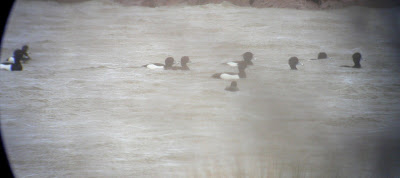Determined to give it my best shot I drove through the darkness, passing a Muntjac with its kid en route, and arrived to start birding at 04.35am. A Pheasant called to announce its presence as I opened my car door, and within a few minutes Tawny Owl was safely secured for the day list. My main target for this cold pre-dawn start was Grey Partridge, but sadly I failed to hear any at all as it slowly became light enough to tell the Red-legged Partridges from the Hares and Rabbits in the ridge field.
I cut my losses and headed for the flash. Here a Little Owl swooped into a tree, but there appeared to be nothing else to see. By 07.15 I was heading for breakfast. I did at least locate a single female Whinchat, hear a distant Cuckoo, and record Nuthatch, Treecreeper, Coal Tit, and Marsh Tit by the time I reached the car, but on balance I felt the morning had been disappointing.
An hour later I was back at Netherstead where I joined Dave hoping for a change in fortune. I was on 50 species, which wasn't too bad really, and we set about mopping up the easy ones I had missed this morning. Linnet, House Sparrow, Buzzard, Robin (would you believe), and Lesser Black-backed Gull all fell as we met up with John who was lurking near where he had seen the Whinchats yesterday. Scoping across the field we located two distant chats, which appeared to be a male and female. While I was watching, Dave called out a Jay. I didn't get on it and the species would elude me all day. Dave then found us a Wheatear, and we saw one of two Little Ringed Plovers which John had seen on the flash. A pair of Starlings was seen before John headed off. Shortly afterwards Dave called
Yellow Wagtail, and I managed to hear it before it was lost behind the hedge. Our last three day ticks before a brief interlude at Haselor scrape were Sparrowhawk, Raven, and House Martin.
At Haselor we saw a Redshank and a Shelduck, but I am not counting those on the day list as I currently regard it as a separate site.
By lunchtime I was dead on my feet and welcomed Lyn's suggestion that I have a power nap. What a poor old soul I am. The hour's kip did me the world of good though, and by 15.00 I was back on site determined to at least try to sketch the male Whinchat. By now the westerly wind, which had been almost non-existent first thing, was both strong and cold. In the lee of a sheltered hedge I had a nice view of a female Blackcap, and on the way to the flash this Fox trotted past.
It seemed to be heading for a lamb's carcass, but eventually sensed me watching and ran off. At the flash I added my 63rd species of the day as a Snipe was in view. Shortly afterwards I scanned the horizon behind me and picked up a suspiciously familiar silhouette. Swinging the scope around I was thrilled to confirm only my second ever
Red Kite on the patch. It was circling low and I could see it twisting its forked tail and splaying its long fingered wings, seen in profile to be kinked downwards from the hand. I thought about whether I had time to risk a record shot but it wasn't really close enough. So instead here is one I drew earlier.
 |
| Red Kite |
I walked up the slope away from the flash hoping to relocate it, but it was nowhere to be seen. Texts were sent to Dave and John (sorry guys) and I prepared to continue toward where the Whinchats were. But suddenly my progress was arrested by a louded piping call. I looked around and watched as an
Oystercatcher flew from the direction of the flash and away over the pool. This was almost as exciting as the Kite. I failed to see one here last year, and this could easily prove to be the only one we get in 2013. I rang John, and as I did so I spotted it again, heading back north and possibly losing height. John could stand it no more and announced he would come back out.
I saw him shortly afterwards but we had different goals, as I went to sketch the pretty stunning male Whinchat and John headed for the flash. Sadly the Oystercatcher must have moved on.
My final day tally was a pretty respectable 65 species, and between us we record 66 on the patch today, only four short of the all time day-list record.















